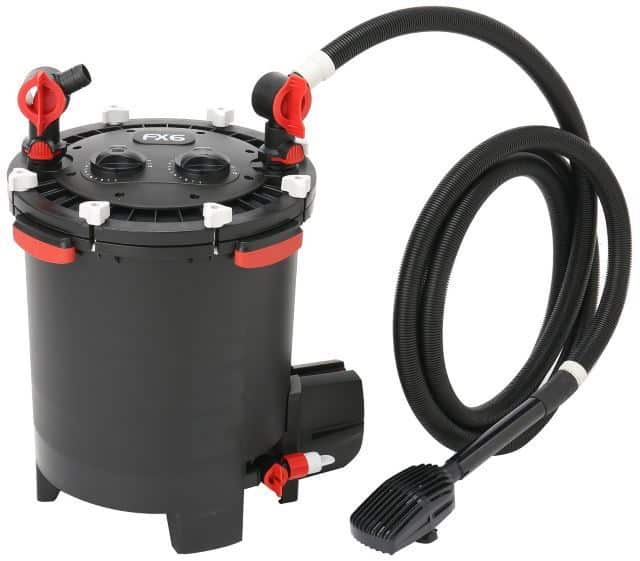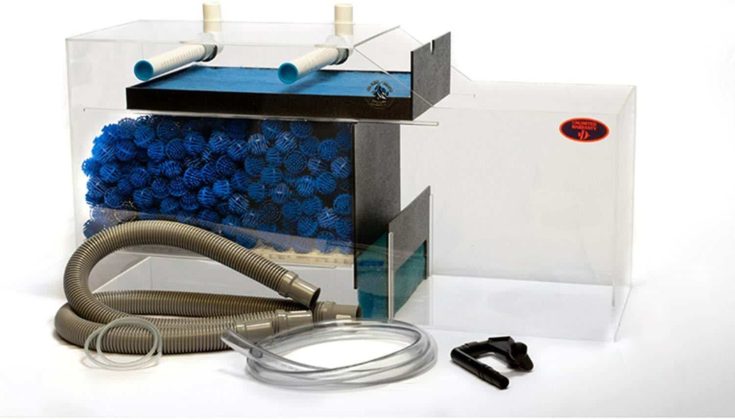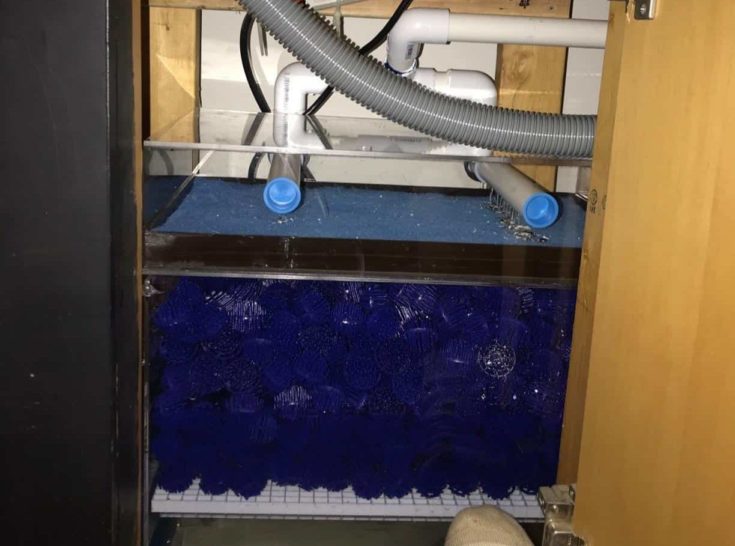In the never-ending quest to find the best filtration setups, you might have come across a particular kind of external trickle-down filter known as a wet/dry filter. If you’ve never seen one before, I’m referring to those large, clear, boxy filters with the long tube and the sump/pump setup.
You undoubtedly wondered about how they work, and how they compare to the ever popular canister filters, no? I’ve wondered the same and figured a quick comparison between the two would be useful so you can see if they might be a good choice to add to your aquarium setup.
Canister Filter VS Wet/Dry Filter Comparisons
| Canister Filter | Wet/Dry Filter |
|---|---|
 |
 |
|
|
Design/Operation
They’re both external filters, but the design on each is different, and the internal workings are also dissimilar in a few ways. In general, wet/dry filters are larger than canister filters. They are rectangular, and, depending on their capacity, will have several subsections where filtration media are held and water enters the filter.
Using a device known as an overflow, water flows out of the fish tank and is carried down to the filter through a drain pipe by gravity. Depending on the size of the filter, this might be a single intake tube or a double intake. The dirty water from your aquarium is then passed through the biological filtration media contained within the “tower portion” of the filter. Mechanical filtration, if it is included, is often located in the filter’s drip tray.

After filtration, the water collected in this reservoir (also called a sump), is then sent back to the tank via a pump that located in the bottom of the filter. Unfortunately, many wet/dry filters don’t include the pump and you’ll have to buy it separately, taking care to ensure that the maximum pumping power of the unit you purchase matches the maximum pumping capacity of the filter you already bought.
The smaller canister filter, on the other hand, is tall and cylindrical and it comes with everything that you need to get started. The internal pump draws water from your aquarium; the pressurized water is forced through the filters internal media trays or media chamber, and the filtered water is then returned to the tank through an output tube.
Performance
Wet/dry filters shine when it comes to biological filtration, as their focus is geared almost exclusively towards it. They have large biofiltration media storage capacity, which can reach upwards of 10 gallons if you get the right model.
Concerning internal capacity, they can vary, but reach up to 35 gallons on some of the largest models. Their flow rates and recommended tank sizes can also become quite high, up 300 gallons @ 1,200 GPH.

The drawbacks? First and foremost, the level of mechanical and chemical filtration is practically nil. They sometimes have cartridges for chemical and mechanical filtration, but they aren’t nearly as effective as what you get with a good canister filter. If you do choose a wet/dry filter for your tank, you’ll need to supplement with another filter for additional water cleaning methods.
Using a wet/dry filter increases the amount of tank water that is lost via evaporation. Also, wet/dry filters almost always have higher initial starting costs (which are increased further by the need to purchase a pump separately).
Canister filters, by comparison, provide above-average levels of all filtration types and is especially effective in regards to mechanical and chemical filtration. They offer a wider range of media that can be used in conjunction with the filter.
Though the maximum flow rates and capacities aren’t as high as wet/dry filters, they still pack a punch, with models like the SunSun Pro filter Kit and the superior Fluval FX6 reaching 400 gallons @ 925 GPH.
Canister filters can also come with additional features like anti-clog strainers, multi-directional outputs, and UV sanitizers to help control algae growth and promote even healthier tank water.
Installation/Maintenance
Both models require a bit of work to get them going, though the installation process on the Canister filter is generally more involved. It requires one to fit various components together, measure and cut tubing, cut and install mechanical filtration media, prime the unit, etc.
Most wet/dry filters, on the other hand, just require one to install the media, set up the overflow box, insert a pump, and attach the necessary hoses. All simple steps.
Canister filters also require a bit more in the way of maintenance. You have to take it apart to wash the pieces and media separately on a regular basis. Wet/dry filters also need regular cleaning, but usually, only require you to remove debris from the filtration media and tubing.
The Verdict
Both filter styles are very powerful, but while wet/dry filters hold the admirable distinction of providing the best biological filtration around, they lack in several key areas that canister filters do not.
Wet-dry filters don’t provide the level of mechanical or chemical filtration many tank owners desire and require a more significant initial investment due to the necessity of buying a separate pump to make them functional.
Contrast canister filters. They might take a bit longer to set up, and they don’t provide quite the same level of biological filtration, but they are by no means disastrous in this regard. Also, they provide exceptional chemical and mechanical filtration, are highly customizable, and usually come with everything you need to hit the ground running.
If you’re the type that enjoys easy maintenance, there are canister filters available that take much of the hassle out of the traditional process of dragging large chambers over to the sink. The Fluval FX6, for instance, features a purge valve and smart pump technology that assists with changing water and maintaining the various components of the filter.

A advantage of a wet/dry filter is that it can serve more than one tank, and that you can top up the water without disturbing the tank(s) in any way.